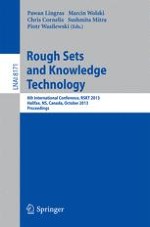This book constitutes the thoroughly refereed conference proceedings of the 8th International Conference on Rough Sets and Knowledge Technology, RSKT 2013, held in Halifax, Canada in October 2013 as one of the co-located conferences of the 2013 Joint Rough Set Symposium, JRS 2013. The 69 papers (including 44 regular and 25 short papers) included in the JRS proceedings (LNCS 8170 and LNCS 8171) were carefully reviewed and selected from 106 submissions. The papers in this volume cover topics such as history and future of rough sets; foundations and probabilistic rough sets; rules, reducts, ensembles; new trends in computing; three-way decision rough sets; and learning, predicting, modeling.
